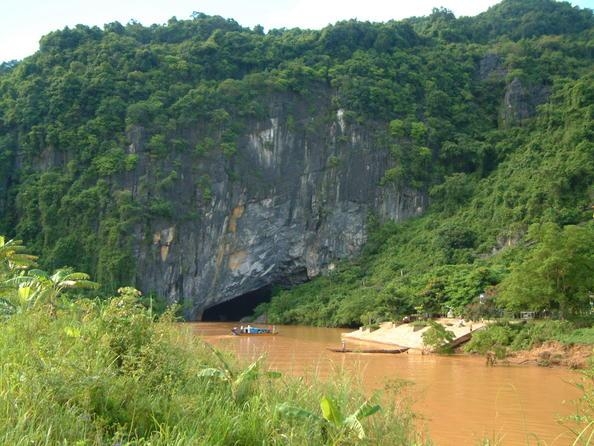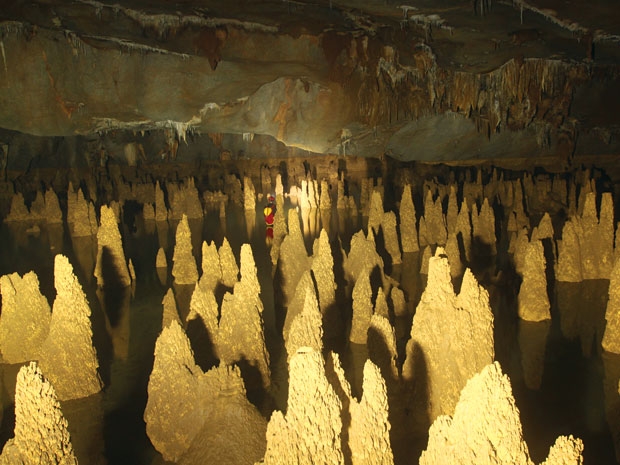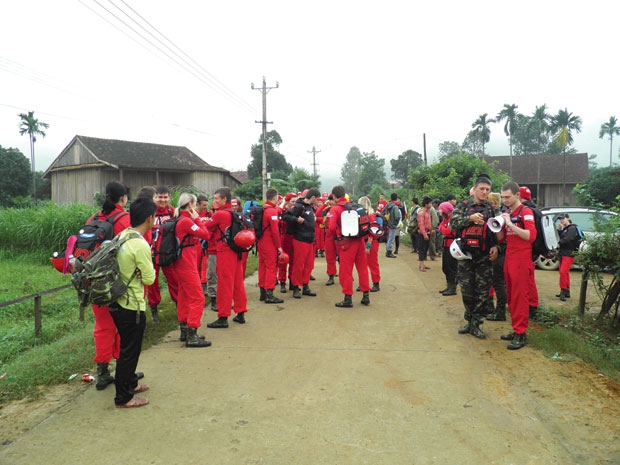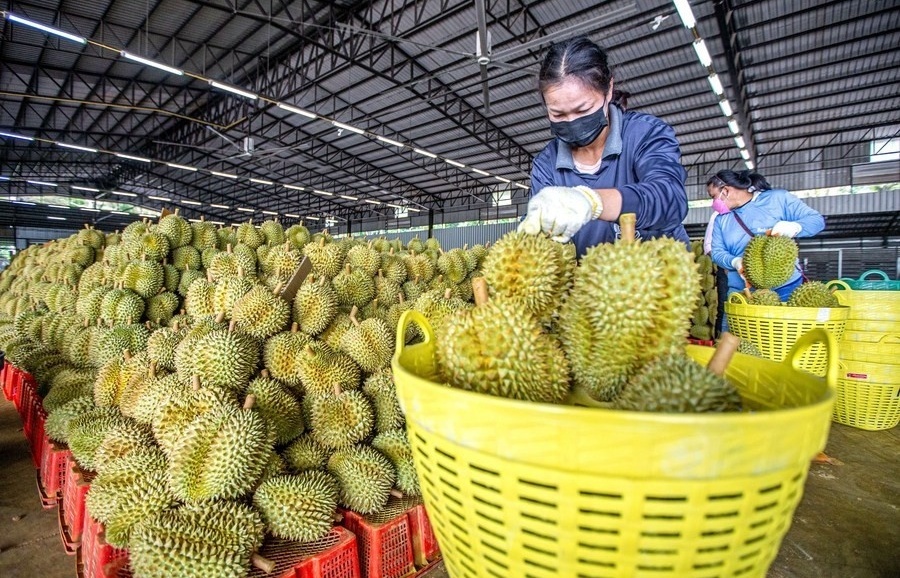Phong Nha: Ten years like a dream!

Phong Nha-Ke Bang National Park - Photo: UNESCO.
This heritage began to be popular in 1991 when the British Caving Association came to explore this site. Since then, Quang Binh has been known internationally with extraordinary cave system.
The cave resources are the motivation to promote the image and sustainable development of Quang Binh.
Forests are everywhere in Vietnam and there are caves too. Any place that has limestone mountains, there are caves there. However, caves in Phong Nha - Ke Bang are unfamiliar with the other. They are exceptionally large, with magnificent stalactites, complicated structures, strange and mysterious about the length and the space.
Prof. Nguyen Quang My, President of the Vietnam Cave Association, commented: "Many years of making research on the caves of the karst (limestone) areas around the country, I can say that nature has generously bestowed Phong Nha stunningly beautiful caves. The rows of silver sparkling stone columns, the thrones of diamonds, bright pink clusters of stalactites on the underground river ... In terms of the length, Phong Nha - Ke Bang is not comparable to the Wind Cave (530km) of the US or the Ease Gill Cave of England (520km), but Phong Nha-Ke Bang is the most magic, mysterious and brilliant cave system in the world. People say that it's natural pride of Vietnam. For anyone, the more they discover the caves, the more they feel surprised about them.”
Like a dream

Each exploration, British scientists claimed to detect from 15-40 new caves in Phong Nha-Ke Bang.
There is a 23 year process of searching caves in Ke Bang. Mr. Howard Limbert, a world famous cave explorer from the UK said: "We are looking at this place as a dream. This means that each year of searching, you will have discovered a new cave to declare to the world, offing an additional invaluable cave resource for people to understand more about an angle of the earth's crust in this tropical land."
The records of 23 years of exploration have created a unique heritage for Quang Binh and Vietnam. From the time the Phong Nha Cave was awarded with the UNESCO world natural heritage ten years ago, the world has then been shocked to know that this barren land has a bright space with the oldest underground rock field, the most beautiful underground sand beach, the longest river cave ... But when experts affirmed the Son Doong cave - the largest cave in the world - in the most narrow area of Vietnam, the world has once again known the name of this limestone land.
After 23 years of searching, foreign explorers have recorded 300 big and small caves, mainly by three cave systems including Phong Nha, Vom and Chay cave systems. A total of more than 153km of caves mapped and measured by the satellite navigation system. It's more unique when these systems are almost parallel with the Road 20 – Quyet Thang amid Phong Nha jungle. A system of 16km of 20 on-the –ground caves and a system of underground caves with the main cave of Khe Ry of 18km long. They complement each other in order to escape flooding in the rainy season.
Experts said that this cave system has been intact for millions or even hundreds of millions of years. It is a very ancient system of space which man has discovered in over two decades. It is the resources for Quang Binh to develop tourism.
For people’s benefit

More foreign tourists explore Phong Nha cave each year.
Mrs. Nguyen Thi Vung in Son Trach was very busy serving dozens of tourists in her small restaurant. This shop has been opened for ten years, with four employees and it mainly serves customers to the Phong Nha-Ke Bang Cave.
Ten years ago, Vung’s family had to struggle with daily meals. Since Phong Nha-Ke Bang became a world heritage site and a tourist attraction, Vung’s family opened this restaurant, which has turned from a thatched house into a big restaurant. Also thanks to the cave, many other families here voluntary changed job from "loggers" to restaurant owners and service providers for tourists, with stable income sources.
Mr. Nguyen Van Hoa, a senior official of Son Trach commune, said Son Trach people greatly benefit from the cave system in Ke Bang, which has become more famous at home and abroad.
Not only people in Son Trach, where the main caves are hosted, those in the neighboring communes of Phuc Trach and Xuan Trach have also earned their livings from offering services for tourists to Phong Nha-Ke Bang. Many young people no longer earn their living from exploiting the forest but by serving tourists.
According to local authorities, Bo Trach district has more than 20,000 local people that directly or indirectly benefit from the cave system, which is very encouraging figure and such a fairy tale. The leaders of Quang Binh see tourism as a driving force for socio-economic development in the province.
Ten years of being a heritage, Phong Nha - Ke Bang has a lot of things to do, but the beauty of this heritage is still the attractive pull of domestic and foreign tourists.
|
Phong Nha – Ke Bang facts and figures: Phong Nha - Ke Bang National Park is located in the middle of the Annamite Mountain Range in Quang Binh province, Vietnam and shares its boundary with the Hin Namno Nature Reserve in the Lao PDR to the west. The property comprises an area of 85,754 ha and contains terrestrial and aquatic habitats, primary and secondary forest, sites of natural regeneration, tropical dense forests and savanna and is rich in large, often spectacular and scientifically significant caves. The property contains and protects over 104 km of caves and underground rivers making it one of the most outstanding limestone karst ecosystems in the world. The karst formation has evolved since the Palaeozoic period (some 400 million years ago) and as such is the oldest major karst area in Asia. Subject to massive tectonic changes, the karst landscape is extremely complex, comprising a series of rock types that are interbedded in complex ways and with many geomorphic features. The karst landscape is not only complex but also ancient, with high geodiversity and geomorphic features of considerable significance. The karst formation process has led to the creation of not only underground rivers but also a variety of cave types including; dry caves, terraced caves, suspended caves, dendritic caves and intersecting caves. With a length of over 44.5 km the Phong Nha cave is the most famous of the system with tour boats able to penetrate inside to a distance of 1,500 m. A large number of faunal and floral species occur within the property with over 568 vertebrate species recorded comprising 113 mammals, 81 reptiles and amphibians, 302 birds and 72 fish. This impressive level of biodiversity and species richness includes a number of endemic species as well as threatened species including tiger, Asiatic black bear, Asian elephant, giant muntjac, Asian wild dog, gaus and the recently discovered sao la. Phong Nha is part of a larger dissected plateau, which also encompasses the Ke Bang and Hin Namno karsts. The limestone is not continuous and demonstrates complex interbedding with shales and sandstones. This, together with the capping of schists and apparent granites has led to a particularly distinctive topography. The caves demonstrate discrete episodic sequences of events, leaving behind various levels of fossil passages, formerly buried and now uncovered palaeokarst (karst from previous, perhaps very ancient, periods of solution); evidence of major changes in the routes of underground rivers; changes in the solutional regime; deposition and later re-solution of giant speleothems and unusual features such as sub-aerial stromatolites. The location and form of the caves suggests that they might owe much of their size and morphology to some as yet undetermined implications of the schists and granites which overlay the limestone. On the surface, there is a striking series of landscapes, ranging from deeply dissected ranges and plateaux to an immense polje. There is evidence of at least one period of hydrothermal activity in the evolution of this ancient mature karst system. The plateau is probably one of the finest and most distinctive examples of a complex karst landform in Southeast Asia. Phong Nha displays an impressive amount of evidence of earth's history. It is a property of very great importance for increasing our understanding of the geologic, geomorphic and geo-chronological history of the region. This national park was listed in UNESCO's World Heritage Sites in 2003 for its geological values as defined in its criteria viii. In April 2009, the world's largest cave, was discovered by a team of British cave explorers of British Caving Association. |
What the stars mean:
★ Poor ★ ★ Promising ★★★ Good ★★★★ Very good ★★★★★ Exceptional
Latest News
More News
- Ba Ria-Vung Tau strengthens regional links to bolster tourism (November 04, 2024 | 10:00)
- Vietnam attracts growing interest from global travellers (October 28, 2024 | 17:59)
- Vietjet receives latest aircraft from Airbus in France (October 08, 2024 | 18:02)
- Telling travel stories through movies (October 08, 2024 | 14:00)
- South Korean tourists lead Vietnam’s tourism revival (October 08, 2024 | 11:49)
- Vietnam a golden land for golf tourism (October 08, 2024 | 11:41)
- Con Dao leads the way in circular tourism (October 08, 2024 | 08:00)
- Nestlé and VNAT announce new cooperation initiative (October 02, 2024 | 15:43)
- Hanoi recognises new city-level tourist areas (September 27, 2024 | 20:25)
- Hue to host 2025 National Tourism Year (September 19, 2024 | 15:13)




















 Mobile Version
Mobile Version